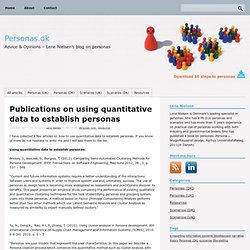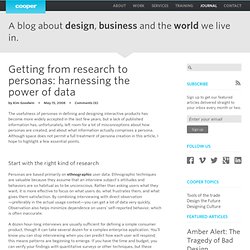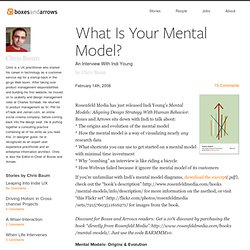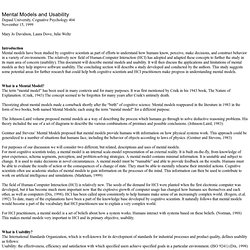

Publications on using quantitative data to establish personas. I have collected a few articles on how to use quantitative data to establish personas.

If you know of more do not hesitate to write me and I will add them to the list. Using quantitative data to establish personas: Brickey, J., Walczak, S., Burgess, T. (2012). Comparing Semi-Automated Clustering Methods for Persona Development. IEEE Transactions on Software Engineering, May-June 2012, 38 , 3, p. 537 – 546 “Current and future information systems require a better understanding of the interactions between users and systems in order to improve system use and, ultimately, success. Tu, N., Dong X., Rau, P. “Personas are user models that represent the user characteristics. Siegel. “Quantitative market research and qualitative user-centered design research have long had an uneasy and complex relationship. McGinn, J. “Much has been written on creating personas — both what they are good for, and how to create them. Erik Markensten , Henrik Artman, (2004).
Hoc.elet.polimi.it/garzotto/pdf/MiLE_UEIs_dec04.pdf. 7 Ingredients of a Successful UX Strategy. By Paul Bryan Published: October 17, 2011.

Planning Your UX Strategy. A strategy is a set of coordinated, orchestrated, planned actions, or tactics, which will take you along a journey to reach a desired future state, over an established period of time.

Design objectives are conditions or outcomes that a project must meet, often of tactical nature. User experience (UX) strategy shouldn’t therefore be confused with design objectives. This article is about how to plan and coordinate actions to organisationally achieve good UX. The idea for this article was sparked by a cacophony of opinions on what constitutes UX strategy voiced recently in the twittersphere. Nothing currently posted in the blogosphere or in the UX community websites about UX strategy hit the right chord with me. I think that the confusion stems partly from Jesse James Garrett’s famous, groundbreaking, commendable book, The Elements of the User Experience, where he employs the term UX strategy to name what was traditionally called a project’s design objectives or goals. Getting from research to personas: harnessing the power of data.
The usefulness of personas in defining and designing interactive products has become more widely accepted in the last few years, but a lack of published information has, unfortunately, left room for a lot of misconceptions about how personas are created, and about what information actually comprises a persona.

Although space does not permit a full treatment of persona creation in this article, I hope to highlight a few essential points. Start with the right kind of research Personas are based primarily on ethnographic user data. Ethnographic techniques are valuable because they assume that an interview subject’s attitudes and behaviors are so habitual as to be unconscious. Rather than asking users what they want, it is more effective to focus on what users do, what frustrates them, and what gives them satisfaction.
Are Personas Still Relevant to UX Strategy? By Paul Bryan Published: January 21, 2013 “Some in the UX community are now saying that personas have been superseded by the availability of more accurate data or by newer UX design and development methods.”

Personas have been a popular approach for guiding the design of Web sites and mobile apps. What Is Your Mental Model? Rosenfeld Media has just released Indi Young’s Mental Models: Aligning Design Strategy With Human Behavior.

Boxes and Arrows sits down with Indi to talk about: * The origins and evolution of the mental model * How the mental model is a way of visualizing nearly any research data * What shortcuts you can use to get started on a mental model with minimal time investment * Why “combing” an interview is like riding a bicycle * How Webvan failed because it ignore the mental model of its customers If you’re unfamiliar with Indi’s mental model diagrams, download the excerpt(.pdf), check out the “book’s description”: for more information on the method, or visit “this Flickr set”: for images from the book. Discount for Boxes and Arrows readers: Get a 10% discount by purchasing the book “directly from Rosenfeld Media”: Just use the code BARMMM10. Mental Models: Origins & Evolution Boxes & Arrows: Our readers would benefit from the story behind the Mental Model. B&A: Interesting. Mental models. Mental Models. Mental Models and Usability Depaul University, Cognative Psychology 404 November 15, 1999.

3 Big UX Lessons Ripped from 2012 Tech Headlines. By Jared M.

Spool Originally published: Jan 02, 2013 Thanks to Marco Dini for translating this article to Italian. User experience was the huge theme across three of the top technology stories for this past year, showing the world how UX has come into its own. Looking at their backstories, we can derive critical lessons for the importance of our work and how to frame it in a global perspective.
The Apple/Samsung Patent Trial: UX Defines Quality On the surface, this story was about a company using the inventions of another company without permission. Yet, just below the surface, the trial’s key message was how desirable a great experience is and what a company will do to achieve it. How good? There were two key pieces of evidence that Apple introduced to the jury.
Samsung was showing some inventiveness in their designs before the iPhone made its debut. Samsung’s QA documentation comparing the iPhone on the left to Samsung’s product on the right. Instagrams’ streamlined UI About the Author.